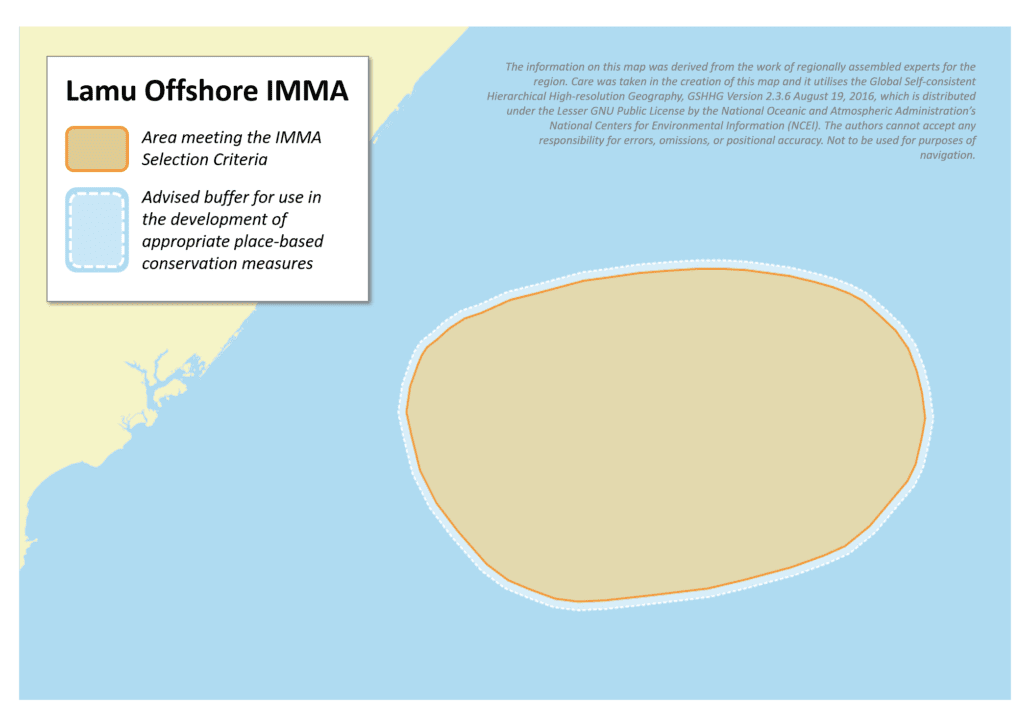Lamu Offshore IMMA
Size in Square Kilometres
61 373 km2
Qualifying Species and Criteria
Blue whale – Balaenoptera musculus
Criterion A
Marine Mammal Diversity
Balaenoptera edeni, Balaenoptera musculus, Globicephala macrorhynchus, Grampus griseus, Indopacetus pacificus, Megaptera novaeangliae, Peponocephala electra, Physeter macrocephalus, Pseudorca crassidens, Stenella longirostris, Tursiops truncatus
Download fact sheet Diversity
Summary
Thirty sightings of blue whales (Balaenoptera musculus) were documented during the first two months of a five-month long seismic survey conducted in the offshore waters of Lamu in northern Kenya. These sightings, all occurring in September and October, suggest that the waters of northern Kenya and southern Somalia are likely to constitute an important habitat for blue whales in the Indian Ocean during the South-East Monsoon period. However, further research is required to determine whether these waters are a feeding ground or part of a migratory route, and which subspecies of blue whale these recent sightings represent. Three recognized subspecies of blue whales occur in the region; the pygmy blue whale (Balaenoptera musculus brevicauda), the Antarctic blue whale (Balaenoptera musculus intermedia), and Northern Indian Ocean blue whale (Balaenoptera musculus indica). The recent identification of a unique blue whale call type recorded off Oman suggests a fourth subspecies also occurs in the Northern Indian Ocean, though this is unconfirmed.
Description of Qualifying Criteria
Criterion A – Species or Population Vulnerability
Globally blue whales (Balaenoptera musculus) are listed by IUCN as ‘Endangered’ (Reilly et al. 2008). At least three of the five recognized subspecies of blue whale (Thomas et al. 2015), are found in the western Indian Ocean: the Antarctic blue whale (B. m. intermedia), the pygmy blue whale (B. m. brevicauda), and the northern Indian Ocean blue whale (B. m. indica; Branch et al. 2007; Anderson et al. 2012). The Antarctic blue whale is red-listed as ‘Critically Endangered’ and the pygmy blue whale as ‘Data Deficient’ (Thomas et al. 2015). An absence of abundance data has precluded assessment of the northern Indian Ocean subspecies (Thomas et al. 2015). Blue whales found in this region represent one of, or a mixture of, the three subspecies known to occur. Additionally, Cerchio et al. (2018) suggested the likelihood of an additional, distinct, population of blue whales, based on the detection of a previously undetected blue whale call type that differs from other subspecies of blue whales that occur in the western Indian Ocean. Thirty confirmed sightings of 38 individual blue whales were made during seismic surveys off the northern Kenyan coast during September and October 2014. The surveys continued until January 2015, but no further blue whale sightings were recorded after October, suggesting that they are seasonally present in the area. Most sightings were of individuals, although groups of up to three were recorded (Barber et al. 2016). September and October mark the end of the South-East Monsoon period, a period of major upwelling and associated productivity, particularly off the Somalia coast (McClanahan 1988; Isaac and Isaac 1968). Whales sighted during the seismic surveys were not identified to subspecies. These sightings suggest that the offshore waters of northern Kenya (and likely southern Somalia) form an important habitat for blue whales in the Indian Ocean, at least during the end of the South-East Monsoon period. Redfern et al. (2017) used habitat models to predict blue whale distribution in the Northern Indian Ocean. It is not known whether these waters represent a feeding ground, a breeding region or part of a migratory route. These observations are broadly consistent with other blue whale sightings recorded within the wider western Indian Ocean, specifically off Somalia and in the Gulf of Aden. These include nineteenth century whaling records made in the Gulf of Aden in September and November (Anderson et al. 2012), Japanese records in March 1982 (Kasuya and Wada 1991), and 18 sightings of blue whales in 1985 off Somalia (October, November and December; Small and Small, 1991).
Supporting Information
Anderson, R.C., Branch, T.A., Alagiyawadu, A., Baldwinm R., Marsac, F. 2012. ‘Seasonal distribution, movements and taxonomic status of blue whales (Balaenoptera musculus) in the northern Indian Ocean’. Journal of Cetacean Research and Management 12:203–218.
Barber, R., Sikora, I. and Nimak-Wood, M., 2016. Blue whales Balaenoptera musculus in offshore waters of Kenya. African Journal of Marine Science, 38(2), pp.279-284.
Cerchio, S., Willson, A., Muirhead, C., Al Harthi, S., Baldwin, R., Cholewiak, D., Minton, G., Minton, T., Willson, M. 2018. A new baleen whale song type described for the Western Indian Ocean off Oman and northwest Madagascar. SC/67B/SH/24 Rev1.
Isaac WM, Isaac FM. 1968. Marine botany of the Kenya coast. 3. Journal of East African Natural History Society 27: 1–28.
Kasuya T, Wada S. 1991. Distribution of large cetaceans in the Indian Ocean: data from Japanese sightings records, November–March. In: Leatherwood E-S, Donovan GP (eds), UNEP Marine Mammal Technical Report 3. Nairobi: UNEP. pp 139–170.
Kenya Marine Mammal Network. 2013. Kenya Marine Mammal Network. Available at www.kenyammnetwork.wix.com/kmmnetwork [accessed 18 June 2015].
McClanahan TR. 1988. Seasonality in East Africa’s coastal waters. Marine Ecology Progress Series 44: 191–199.
Redfern, J.V., Moore, T.J., Fiedler, P.C., de Vos, A., Brownell, R.L., Forney, K.A., Becker, E.A. & Ballance, L.T. (2017) Predicting cetacean distributions in data-poor marine ecosystems. Diversity and Distributions.
Small JA, Small GJ. 1991. Observations from the Somali Democratic Republic, September 1985 through May 1987. UNEP Marine Mammal Technical Report 3. pp 179–210.


